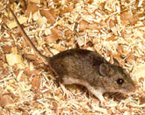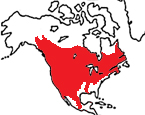|
North
American Deermouse
(Peromyscus maniculatus bairdi) |
||||
|
|
Physical
characteristics and distribution
|
|
Peromyscus maniculatus bairdii has a shorter tail, ears, skull, and hind foot than P. m. gracilisis It is grayish to reddish brown with white underparts. The fur is short, soft, and dense. The finely-haired tail is bicolored, the darker top half and the lighter bottom sharply differentiated. They are primarily a nocturnal species. Peromyscus maniculatus bairdii spends most of its time on the ground but it is also an adept climber. Activity centers around a nest and food cache. In terrestrial prairie subspecies, a nest is constructed just below ground level in its own burrow or one abandoned by another animal. Forest dwelling subspecies construct nests near the ground in stumps, logs, brush piles, tree cavities, reconstructed bird nests, tree bark, or even cottages or outbuildings. Nests are made of rounded masses of vegetable matter (as much as 100 mm in diameter). It is omnivorous. It eats a wide variety of plant and animal matter depending on what is available, including insects and other invertebrates, seeds, fruits, flowers, nuts, and other plant products. At birth, the Peromyscus maniculatus bairdii has a mass of about 1.5 g. The young are born hairless with wrinkled, pink skin, closed eyes, and folded over ear pinnae. Juvenile hair begins to develop on the second day after birth. On the third day, the pinnae unfold with the ear canal opening on the tenth day. Eyes open on the fifteenth day, and the young are weaned between day 25 and 35. Conception can occur as early as 35 days, but the first estrus typically occurs around 49 days. Peromyscus maniculatus bairdii are found in forested areas in the Panhandle of Alaska and across N Canada, south through most of continental USA, excluding the SE and E seaboard, to southernmost Baja California and to Sur NC Oaxaca, Mexico; including many landbridge islands. In Michigan, Peromyscus maniculatus bairdii is found in open areas (preferably plowed or cultivated fields, early stages of grasslands, or along lake shores) of the Lower Peninsula and the southwestern Upper Peninsula.(see details: Mammal Species of the World, Vol 2, 2005, p1071-2). |
|
Description
of the brain
|
|
Animal
source and preparation
|
|
All
specimens collected followed the same preparation
and histological procedure.
|
Other Related Resources (websites and publications)
List of Specimens | Explore Collections | Brain Sections | Brain Evolution | Brain Development | Brain Circuitry | Brain Functions | Location and Use | Related Web Sites | Contact Us | Search MSU Database | Personnel | Home



